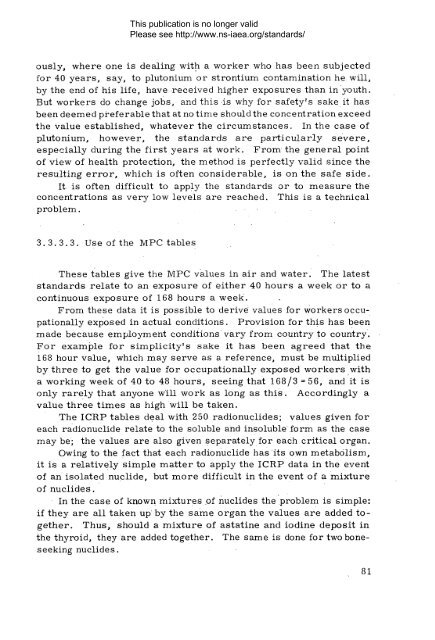Safety_Series_025_1968 - gnssn - International Atomic Energy ...
Safety_Series_025_1968 - gnssn - International Atomic Energy ...
Safety_Series_025_1968 - gnssn - International Atomic Energy ...
You also want an ePaper? Increase the reach of your titles
YUMPU automatically turns print PDFs into web optimized ePapers that Google loves.
This publication is no longer validPlease see http://www.ns-iaea.org/standards/ously, where one is dealing with a worker who has been subjectedfor 40 years, say, to plutonium or strontium contamination he will,by the end of his life, have received higher exposures than in youth.But workers do change jobs, and this is why for safety's sake it hasbeen deemed preferable that at no time should the concentration exceedthe value established, whatever the circumstances. In the case ofplutonium, however, the standards are particularly severe,especially during the first years at work. From the general pointof view of health protection, the method is perfectly valid since theresulting error, which is often considerable, is on the safe side.It is often difficult to apply the standards or to measure theconcentrations as very low levels are reached. This is a technicalproblem.3. 3. 3. 3. Use of the MPC tablesThese tables give the MPC values in air and water. The lateststandards relate to an exposure of either 40 hours a week or to acontinuous exposure of 168 hours a week.From these data it is possible to derive values for workers occupationallyexposed in actual conditions. Provision for this has beenmade because employment conditions vary from country to country.F or example for sim plicity's sake it has been agreed that the168 hour value, which may serve as a reference, must be multipliedby three to get the value for occupationally exposed workers witha working week of 40 to 48 hours, seeing that 168/3 = 56, and it isonly rarely that anyone will work as long as this. Accordingly avalue three times as high will be taken.The ICRP tables deal with 250 radionuclides; values given foreach radionuclide relate to the soluble and insoluble form as the casemay be; the values are also given separately for each critical organ.Owing to the fact that each radionuclide has its own metabolism,it is a relatively simple matter to apply the ICRP data in the eventof an isolated nuclide, but more difficult in the event of a mixtureof nuclides.In the case of known mixtures of nuclides the problem is simple:if they are all taken up by the same organ the values are added together.Thus, should a mixture of astatine and iodine deposit inthe thyroid, they are added together. The same is done for two boneseekingnuclides.81
















